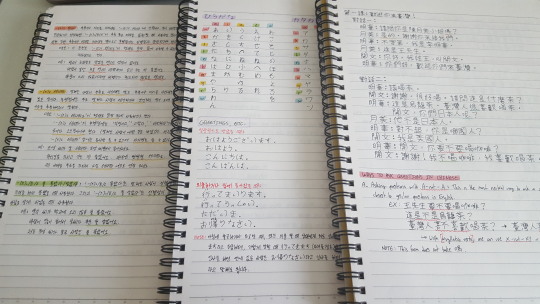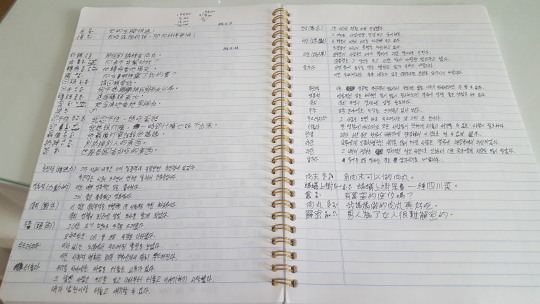Hello! I'm just a new Langblr who wants to learn Mandarin , Korean , and jaoanese! My name is Zoë, I live in NY, and I'm 17.years old c:
Don't wanna be here? Send us removal request.
Text
So I found this cool website for learning ancient languages
go wild
306K notes
·
View notes
Text
A year from now, you’ll be happy you started today
12K notes
·
View notes
Text
Study organization- notebooks
I love stationery of all kinds, especially notebooks. And when you’re planning on studying, of course you need notebooks for taking notes and practicing! In this post, I’ll talk a little about my notebooks.
What kind(s) of notebook(s) do you use?
My personal preference is for spiral notebooks. I used to use notebooks that just opened like normal books, but they never liked to stay flat and they took up too much space on my desk. It’s funny because I used to hate spirals back when I was younger and way into drawing because the pages were more free to move against each other which led to more smudging, but I love spirals so much for note taking. They lay flat with no problem, which is the biggest thing for me. The spiral does get in the way of my hand sometimes, but it’s a minor annoyance.
I also consider the quality of the paper when buying my notebooks. It doesn’t have to be super high quality, but I just can’t deal with paper the quality of standard US looseleaf. It’s too thin and, more importantly, the surface is too rough. Paper with too rough a surface has led to the early death of too many of my pens—if you use fine-tip pens, size 0.5 or lower, and find they stop writing before the ink runs out—little bits from poor-quality paper probably got into the tip and ruined it. The paper I like the most feels a little bit weighty and nice and smooth!
Hardcover or softcover is also a choice to make! I use both, types:
Left to right- hardcover lined notebook, softcover lined notebook, softcover 원고지 squared paper notebook

How many notebooks do you use?
I have three main types of notebooks! I’ll go over each type:
Grammar notebooks

My grammar notebooks are all hardcover. I use them to collect grammar explanations and other important notes. I write them as cleanly as possible and even use my many colorful highlighters to make them look a little nicer. If I need to know about a grammar point that I have already learned, I open my grammar notebook for the right language and find it. This way, I don’t have to remember which textbook or source I saw a certain grammar point or explanation in—if it’s important, I write it down in my grammar notebook! So, my grammar notebooks are mashups of multiple texts and sources. These are for reference only; I don’t do any practice or extra writing in them. Nothing but the facts!
Practice notebooks

My practice notebook is where I write down definitions of new words I learned, practice sentences for my vocab flashcard words, breakdowns of articles I’ve studied on my Chinese reader apps… I guess calling it a “practice notebook” makes its purpose pretty self-explanatory. It’s nothing special; I write quickly and messily in it, and when it gets full, I can just throw it in the recycling bin and start a fresh one. My practice notebook is a softcover spiral.
Chinese article notebook

Korean squared paper—or I guess any squared paper—is wonderful for writing Chinese characters. Once I’ve encountered an article in a Chinese reader app and broken it down in my practice notebook, I rewrite it cleanly in my article notebook so I can easily find and read it again later.
I don’t always have all of my notebook types with me. If I plan on studying grammar, I will bring the correct grammar notebook along, and if I plan on studying Chinese articles, I might have my article notebook with me, but not always. However, my practice notebook is always in my bag!
How do you organize your notes and all? For those of you who might be struggling to get your notes together, I hope this helped!
Happy studying~
5K notes
·
View notes
Text
40 Important Mandarin Chinese Verbs!

1. 是 [shì] ~ (to) be
2. 有 [yǒu] ~ (to) have
3. 做 [zuò] ~ (to) do; (to) make
4. 可以 [kě yǐ] ~ can; (to) give permission
5. 认识 [rèn shí] ~ (to) be acquainted qith
6. 知道 [zhī dào] (怎样) (zěn yàng) ~ (to) know (be aware)
7. 理解 [lǐ jiě] ~ (to) understand
8. 讲 [jiǎng] ~ (to) speak; (to) talk
9. 听 [tīng] ~ (to) listen to
10. 听到 [tīng dào] ~ (to) hear
11. 看 [kàn] ~ (to) see
12. 觉得 [jué de] ~ (to) feel
13. 活着 [huó zhe] ~ (to) live
14. 要 [yào] ~ (to) want
15. 需要 [xū yào] ~ (to) need
16. 喜欢 [xǐ huān] ~ (to) like
17. 爱 [ài] ~ (to) love
18. 给 [gěi] ~ (to) give
19. 拿 [ná] ~ (to) take
20. 玩 [wán] ~ (to) play
21. 笑 [xiào] ~ (to) laugh
22. 来 [lái] ~ (to) come
23. 去 [qù] ~ (to) go
24. 坐 [zuò] (…) 去 [qù] ~ (to) go by (…) (e.g. by car)
25. 写 [xiě] ~ (to) write
26. 读 [dú] ~ (to) read
27. 计数 [jì shù] ~ (to) count
28. 发音 [fā yīn] ~ (to) pronounce
29. 拼 [pīn] ~ (to) spell
30. 共轭 [gòng è] ~ (to) conjugate
31. 记住 [jì zhù] ~ (to) remember
32. 忘记 [wàng jì] ~ (to) forget
33. 吃 [chī] ~ (to) eat
34. 试 [shì] ~ (to) try
35. 用 [yòng] ~ (to) use
36. 打开 [dǎ kāi] ~ (to) open
37. 关闭 [guān bì] ~ (to) close
38. 欢迎 [huān yíng] ~ (to) greet; (to) welcome
39. 开始 [kāi shǐ] ~ (to) begin
40. 结束 [jié shù] ~ (to) end
6K notes
·
View notes
Text
Cat Town, Japan.
Listen up, y’all. I’m about to tell you guys about the #1 cat lady destination in Japan: Yanaka.

Yanaka is a neighborhood in Taitō Ward, Tokyo. It’s a super traditional part of town filled with winding alleys, shrines and meticulously maintained temples. It’s a lovely place, but today we’re here to focus on the thing that makes Yanaka a magnet for nerds like me: good good kitties.

You see, Yanaka is a neighborhood with a butt-ton of stray cats. This makes sense, since it’s basically cat heaven. The streets and alleys of Yanaka are essentially just a series of hidey holes and ideal sunning spots that happen to have humans running around. Thankfully these humans are quite appreciative of their feline overlords, which is why part of Yanaka has essentially just become cat themed. It’s honestly like the neighborhood has just agreed that this is their thing now.

The first cat-themed establishment we visited in Yanaka was Nekoemon, a café with a scant 13 seats that’s covered in cat decor. The special thing about this place is that they offer a set (for roughly $15USD) that includes a cat-shaped cookie, a coffee drink of your choice and a little unfinished maneki neko figurine. Why the figurine? ‘Cause you’re about to customize yourself a neko, my friend.

The owner asked customers to choose between figurines to attract either luck or money. We picked luck and got our maneki neko along with a full assortment of markers. The owner even set out a few already painted figurines to provide inspiration.

Aside from the novel figurine offer, the café also had genuinely delicious lunch sets. They weren’t cat themed (though they had plenty of dessert options that were), but it was healthy and extremely tasty. I honestly recommend Nekoemon on all fronts.
Here’s my finished maneki neko. Followers of the blog may recognize him.

Nekoemon is great, but it isn’t even at the center of the cat madness. No, for that we’re headed to the shopping area: Yanaka Ginza.

Even if you don’t care about cats (in which case I’ve got to ask… why did you read this far?) this street is lovely. There are shops for handcrafted items, souveniers, sweets, savory foods and a lot more.

If you aren’t all sugared up from Nekoemon, you can always stop by Yanaka Shippoya, a shop that sells cat tail donuts. The donuts are named as cats would be rather than for their flavors, and they’re honestly very nice. We had a sesame camembert one that was lovely and not too sweet.

Donuts not your bag? You can always satisfy your sweet tooth with some maneki neko shaped taiyaki from Maneki-ya. Fluffy outside, rich and creamy inside. We got the matcha custard and red bean flavor and it did not disappoint.

Okay, so you’ve had enough sugar to last you a lifetime. Know what has no calories? Cat accessories. Yanaka Ginza has a bunch of shops that specialize in just… cat stuff. Cat jewelry? Check. Cat kitchenware? Check. Cat bento? Check. Cat bags? Dear heavenly lord, check. There’s even a store that specializes in making custom cat stamps. Seriously.

That’s just one tiny corner of just one shop. We visited 3, but saw more. Most of the shops had signs asking visitors to refrain from taking photos, so we kept the camera packed away. Honestly, I get it. These are shops best explored in person. It’s fun to see how the owner of each shop has a unique aesthetic and stocks totally different items (though there is certainly some overlap). You can tell these stores are curated by cat lovers.

Oh, and of course we can’t forget the feline residents themselves. When we first hit the area we saw zero cats. None. I was honestly really disappointed, but it turns out they were all hiding from the rain that started shortly after. Those kitty instincts served them well and kept them dry, and once the rain passed we suddenly saw little cat faces poking out all over.
This sweet girl roamed the cemetery and was the first kitty we met.

Shortly after we met a pair of housecats that chirped at us quite enthusiastically.



This orange boy said goodbye to us just before we left the area.

In conclusion: if you love fluffbutts and toe beans and are near Tokyo, get thee to Yanaka. It’s a fantastic weekend day trip that isn’t crowded to the brim with tourists, the whole neighborhood has a relaxed and peaceful vibe, and you can come home decked out in cat stuff and filled with sugar. What more could you even want?
7K notes
·
View notes
Text
Cat Town, Japan.
Listen up, y’all. I’m about to tell you guys about the #1 cat lady destination in Japan: Yanaka.

Yanaka is a neighborhood in Taitō Ward, Tokyo. It’s a super traditional part of town filled with winding alleys, shrines and meticulously maintained temples. It’s a lovely place, but today we’re here to focus on the thing that makes Yanaka a magnet for nerds like me: good good kitties.

You see, Yanaka is a neighborhood with a butt-ton of stray cats. This makes sense, since it’s basically cat heaven. The streets and alleys of Yanaka are essentially just a series of hidey holes and ideal sunning spots that happen to have humans running around. Thankfully these humans are quite appreciative of their feline overlords, which is why part of Yanaka has essentially just become cat themed. It’s honestly like the neighborhood has just agreed that this is their thing now.

The first cat-themed establishment we visited in Yanaka was Nekoemon, a café with a scant 13 seats that’s covered in cat decor. The special thing about this place is that they offer a set (for roughly $15USD) that includes a cat-shaped cookie, a coffee drink of your choice and a little unfinished maneki neko figurine. Why the figurine? ‘Cause you’re about to customize yourself a neko, my friend.

The owner asked customers to choose between figurines to attract either luck or money. We picked luck and got our maneki neko along with a full assortment of markers. The owner even set out a few already painted figurines to provide inspiration.

Aside from the novel figurine offer, the café also had genuinely delicious lunch sets. They weren’t cat themed (though they had plenty of dessert options that were), but it was healthy and extremely tasty. I honestly recommend Nekoemon on all fronts.
Here’s my finished maneki neko. Followers of the blog may recognize him.

Nekoemon is great, but it isn’t even at the center of the cat madness. No, for that we’re headed to the shopping area: Yanaka Ginza.

Even if you don’t care about cats (in which case I’ve got to ask… why did you read this far?) this street is lovely. There are shops for handcrafted items, souveniers, sweets, savory foods and a lot more.

If you aren’t all sugared up from Nekoemon, you can always stop by Yanaka Shippoya, a shop that sells cat tail donuts. The donuts are named as cats would be rather than for their flavors, and they’re honestly very nice. We had a sesame camembert one that was lovely and not too sweet.

Donuts not your bag? You can always satisfy your sweet tooth with some maneki neko shaped taiyaki from Maneki-ya. Fluffy outside, rich and creamy inside. We got the matcha custard and red bean flavor and it did not disappoint.

Okay, so you’ve had enough sugar to last you a lifetime. Know what has no calories? Cat accessories. Yanaka Ginza has a bunch of shops that specialize in just… cat stuff. Cat jewelry? Check. Cat kitchenware? Check. Cat bento? Check. Cat bags? Dear heavenly lord, check. There’s even a store that specializes in making custom cat stamps. Seriously.

That’s just one tiny corner of just one shop. We visited 3, but saw more. Most of the shops had signs asking visitors to refrain from taking photos, so we kept the camera packed away. Honestly, I get it. These are shops best explored in person. It’s fun to see how the owner of each shop has a unique aesthetic and stocks totally different items (though there is certainly some overlap). You can tell these stores are curated by cat lovers.

Oh, and of course we can’t forget the feline residents themselves. When we first hit the area we saw zero cats. None. I was honestly really disappointed, but it turns out they were all hiding from the rain that started shortly after. Those kitty instincts served them well and kept them dry, and once the rain passed we suddenly saw little cat faces poking out all over.
This sweet girl roamed the cemetery and was the first kitty we met.

Shortly after we met a pair of housecats that chirped at us quite enthusiastically.



This orange boy said goodbye to us just before we left the area.

In conclusion: if you love fluffbutts and toe beans and are near Tokyo, get thee to Yanaka. It’s a fantastic weekend day trip that isn’t crowded to the brim with tourists, the whole neighborhood has a relaxed and peaceful vibe, and you can come home decked out in cat stuff and filled with sugar. What more could you even want?
7K notes
·
View notes
Photo







The baby girl that was born just a few hours ago… her father wants to drown her in milk because he didn’t receive a male heir!
Rekha as Ramdulaari // Lajja (2001)
490K notes
·
View notes
Text
when cats r really excited to see you and they come trotting as fast as their lil leggys can carry them and go ‘prrrt!’ the whole time reblog if you agree?
148K notes
·
View notes
Note
Do you have any tips for studying a large amount in a short period of time? Because I have been learning chinese for 2 1/2 years, but i really haven't gotten far and this August 29 (50 days!!) I'm leaving for a 10 month exchange to ZhengZhou!
i’m gonna start out by saying there’s really no fun way to cram a bunch of knowledge into your brain in a short amount of time (i know this really well bc i was a shit student in high school and i still a shit student now, even though i have improved slightly)
but here are my suggestions:
make some kind of schedule. if you do this you don’t need to have a super regimented study plan but just have an idea of what you need to study and make a basic timeline. you leave in 50 days, so that’s about 7 weeks. while you don’t necessarily need to know what you’re going to study every single day, maybe have a general idea about what you want to cover each week so that you can have a general idea of what your goal is
if scheduling isn’t your thing (cuz it sure as hell isn’t mine), form a list of what you want to accomplish in these 50 days. gather up the resources you’re gonna use (i’ll put some suggestions for that below) and figure out what you want to accomplish with them. this list can be as general or specific as you think it needs to be.
whether you make a schedule or a list is really up to you and how you prefer to study and stay motivated, but it’s important to remember to take a few days off (at least once a week). 50 days of straight studying is not an easy thing and if you don’t rest in between you’ll eventually burn out. so yeah, take some days off. but if you still want to get some mandarin practice in, listen to music in the background. here’s some links to music master posts, as well as my mandarin music tag (my personal suggestions for music are, naturally, 苏运莹, 张震岳 (AKA A-Yue,Waa Wei, Hello Nico, Haya 乐团, Frandé/法蘭黛, and 宇��人). also take a look at the blogs @chinese-lyrics and @fyeahcindie. they have a bunch of great music that you can look through
so now that you know what you’re gonna be doing, here are some suggestions for how to drill vocab and grammar:
the first is memrise. there are a bunch of memrise courses for mandarin that cover useful vocab from every level of the HSK among other things. since it uses spaced repetition it’s a great resource to help beat vocab into your brain. it is, however, not the best for grammar (imo)
if you need to, take sticky notes and label everything in your house. and make it really visible. when i did this, i didn’t write the pinyin on the sticky notes, just the tone marks but if you feel that you need to write the pinyin, then go ahead and do it. when you do this, you are forced to see the vocab every day and will learn it after having seen it so many times
it is my opinion that the best way to learn vocab (and their corresponding characters) is to write. when i study mandarin i always try to write out my vocab lists and then use this method to practice the characters. depending on how long your vocab list is, this can be an incredibly time consuming method (i’ve had lists that have taken me an hour and a half to finish drilling using this method) but it really pays off
for grammar i’d use websites like this one or this one bc they give examples of the grammar in use. also, the first one (allset learning) has their grammar organized up to B2 (HSK 4) so it’s easy to find grammar by HSK levels. the second one is also organized by level, but they don’t have as many articles yet. if you want to practice by making your own sentences but are afraid of messing up, just hop on over to HiNative. you can ask native speakers of mandarin if something you wrote in mandarin sounds natural or correct, as well as ask for help with translating difficult words or sentences and more.
more than anything, i recommend you find some resources created by native speakers to help you learn
slow chinese 慢速中文 is a podcast series written by native speakers for people learning mandarin. they are a few minutes long each and are spoken at a slightly slower speed than normal, and they cover a variety of topics including chinese culture and food. you can download the podcasts on iTunes, but you can also find them online along with the transcripts. it’s an amazing resource
快乐汉语 (this playlist only goes to episode 75): this is a video series created by CCTV for mandarin learners. it’s basically about an american girl who runs away from home to stay with her family friends in beijing. the acting is super cheesy and the plots are downright weird at times, but it’s an excellent resource because the videos are subbed in both mandarin and english. since susan (the main character) is american, there are a bunch of episodes where the family explains chinese culture to her so it’s pretty cool. warning: a lot of the characters have thick beijing accents, so just watch out for that. they also have a couple of short breaks in each episode to explain certain grammar or vocab that was used in the episode
what i’d do with these and any other native resources you find (song lyrics, blog posts, books, etc.) is break them down sentence by sentence and study the vocab and grammar. once you get that vocab, drill it like you do with all of the other vocab. what my teacher would have us do with 快乐汉语 was listen once nonstop, then go scene by scene and write down what the characters were saying using what we could hear and the chinese subtitles. we’d then go over the scene and find any vocab and grammar patterns that were new to us and make notes on them. once we’d finish with that, we’d listen to the scene once more.
after we’d done that for every scene, we’d watch the whole video again and again to get the hang not only of the new vocab but also of the way the characters said each sentence. when learning a new language, a lot of what makes someone sound unnatural is not only accent, but also rhythm. so my teacher would have us listen to the video over and over and then make us perform certain scenes. she did this so we could practice listening not only for pronunciation but also for the rhythm of each sentence. so i highly recommend you try this (sans the performing). you can just pick a scene or two and listen a bunch and eventually try to repeat after each character until you feel you’ve got the rhythm down.
so that’s really all i can say for now. cramming requires a lot of work so what you’ve got to do is find a way to apply the methods that work best for you and keep plugging away at them until the very end. i hope this helps you in some way, and i hope you enjoy your time in china! 加油!!!
140 notes
·
View notes
Text
好巧!What a coincidence!
Hǎo qiǎo! What a coincidence! (Literally, “How coincidental!”)
347 notes
·
View notes
Photo


SHE ACTUALLY LIKED THIS FOR ABOUT A MINUTE OMFG

55K notes
·
View notes
Text
Korean, Japanese and Mandarin langblrs please reblog this! I’d love for my dash to be filled with as many language resources as possible xx
257 notes
·
View notes
Text
my favorite mandarin songs (with one exception)
this is just a list of my favorite songs written in mandarin (and one in mongolian that has mandarin subs and was aired on chinese television so fight me)
i put the videos for the first five bc i love them so much that you have to listen to them right now
also, this is obviously not a comprehensive list. hope you enjoy!
1. 飛翔的鷹 (HAYA 樂團)
youtube
2. 輪迴 (杭蓋樂團)(this is the exception. it’s fucking rad so i had to include it)
youtube
3. 螢火蟲 (蘇運瑩)
youtube
4. 知足 (五月天)
youtube
5. 明冥(蘇運瑩)(mingming is the title track of my one true love su yunying’s album. it is on spotify. go listen to the whole thing it is amazing)
youtube
6. 我是一隻小小鳥 (趙傳) link
7. 愛不愛 (Waa Wei) link
8. 野子(蘇運瑩)link
9. 愛的初體驗(A-Yue)link
10. 水長流(劉鳳屏) link
11. 寶貝,對不起(草蜢 )link
(note: my simplified keyboard was not working so i had to type traditional)
315 notes
·
View notes


